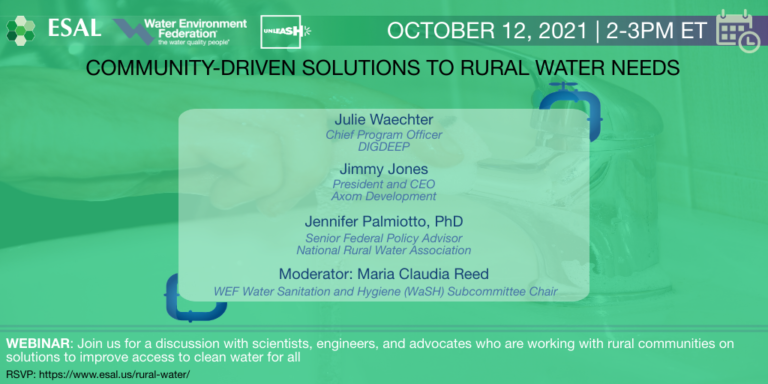
Fact: 2.2 million Americans do not have running water or basic plumbing. In high income countries, such as the U.S., access to sanitary water is not a guarantee.
Julie Waechter, chief program officer at DigDeep, presented these facts during the “Community-driven Solutions to Rural Water Needs” event, a virtual panel co-hosted by ESAL and the Water Environment Federation (WEF) on October 12. This event also featured presentations by Jimmy Jones, president and CEO of Axom Development, and Jennifer Palmiotto, senior federal policy advisor for the National Rural Water Association (NRWA). The panel was moderated by Maria Claudia Reed of WEF and focused on the importance of culturally sensitive solutions.
Waechter’s organization, DigDeep, is a “human rights nonprofit working to ensure that every American has clean, running water forever.” Headquartered in Los Angeles, DigDeep coordinates projects in rural regions by tailoring solutions to the local context. In the Navajo Nation where population is sparse, they’ve installed solar-powered home water systems, while in the Appalachian region of West Virginia, they’ve partnered with the local food bank and water utility to repair existing lines. An overarching goal, according to Waechter, is to develop an information source, which currently doesn’t exist, with data on water access.
Next, Jones discussed the motivation behind his efforts to promote water equity. As a native of Louisiana with ties to minority communities, Jones founded Axom Development after extensive experience working in water management across his home state, where water pipelines can be over 100 years old. At Axom, he now consults for municipal water projects while adhering to principles of diversity and inclusion. In minority cities, Jones focuses on educating constituents and empowering them to advocate for their own desired outcomes instead of letting outside interests dictate development.
“You have companies and engineers coming from all over the world to address the pipes, but nobody is addressing the people,” said Jones. Understanding funding sources, for example, can help residents exercise political clout and financial independence.
Finally, Palmiotto presented on the mission-driven work of the NRWA, a nonprofit that supports rural water systems throughout the country. The organization works with an established network of state associations to provide technical training and assistance to water operators underpinning small, rural populations. In their various programs, Palmiotto emphasized the role of relationship-building to implement projects from the ground up, not top down.
Unsurprisingly, race has been shown to be the leading indicator of whether an American household has access to running water. Waechter shared the statistic that black and brown households are twice as likely than white households to lack access, whereas Native American households are a staggering 19 times more likely.
“You have to develop that trust and the trust takes time,” advised Palmiotto, based on personal experience from getting involved in her town’s water project. “There is no one size fits all. Every community has its own personality.”
The running theme of the discussion, echoed by all three panelists: get to know the community. In matters of water access, local stakeholders and citizens should be enabled to shape the process and imprint it with their own unique values.
A recording of this event is available.